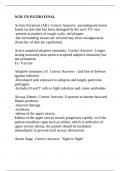Nur 376 final - Study guides, Class notes & Summaries
Looking for the best study guides, study notes and summaries about Nur 376 final? On this page you'll find 19 study documents about Nur 376 final.
Page 2 out of 19 results
Sort by
NUR 376 PATHO FINAL
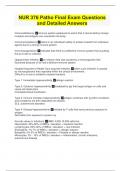 Popular
Popular
-
NUR 376 Patho Final Exam Questions and Detailed Answers
- Exam (elaborations) • 14 pages • 2024 Popular
-
Available in package deal
-
- $10.99
- 1x sold
- + learn more
Immunodeficiency Immune system weakened to extent that it cannot destroy foreign invaders and antigens can overwhelm the body. Immunocompetence refers to an individual's ability to protect oneself from infectious agents due to a strong immune system. Immunosuppression indicates that there is a defective immune system that is putting the pt at risk for infection. Opportunistic Infection an infection that was caused by a microorganism that flourished because of its host's deficient immune sys...
NUR 376 Patho Final Exam With Correct Answers.

-
NUR 376 Patho Final/ 109 Quizzes wit Certified Ans/ 2024-2025
- Exam (elaborations) • 27 pages • 2024
-
- $9.99
- + learn more
NUR 376 Patho Final/ 109 Quizzes wit Certified Ans/ . Terms like: Key lab values in Infections - Answer: WBC 4,000-10,000 cells/mcL Neutrophils: 40%-80% of WBCs / elevation = bacterial infection Lymphocytes: 20%-40% of WBCs / elevation = viral infection Eosinophils: 1%-7% of WBCs / elevation = allergic reaction Basophils: 0%-2% of WBCs / elevation = Parasite or allergic reaction Monocytes: 2% - 10% of WBCs / elevation = Inflammation, chronic infections, autoimmune disease
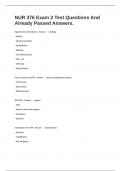
-
NUR 376 Applied Pathophysiology Package Deal Bundle Graded A+.
- Package deal • 5 items • 2024
-
- $28.27
- + learn more
1 Exam (elaborations) NUR 376 PATHO FINAL EXAM QUESTIONS WITH SOLVED SOLUTIONS. 2 Exam (elaborations) NUR 376 Pathophysiology Exam 1 Test Questions And Complete Answers. 3 Exam (elaborations) NUR 376 Exam 2 Practice Exam Questions And Complete Answers. 4 Exam (elaborations) NURSING 376 EXAM 1 QUESTIONS AND ALL CORRECT ANSWERS. 5 Exam (elaborati
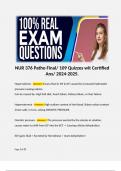
-
NUR 376 Patho Final/ 109 Quizzes wit Certified Ans/ 2024-2025.
- Exam (elaborations) • 27 pages • 2024
-
- $9.49
- + learn more
NUR 376 Patho Final/ 109 Quizzes wit Certified Ans/ . Terms like: Hypervolemia - Answer: Excess fluid in ISF & ICF caused by increased hydrostatic pressure causing edema Can be caused by: High Salt diet, heart failure, kidney failure, or liver failure. Hypernatremia - Answer: High sodium content of the blood. Raises solute content (more salt), in turn, raising OSMOTIC PRESSURE.
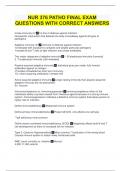
-
NUR 376 PATHO FINAL EXAM QUESTIONS WITH CORRECT ANSWERS
- Exam (elaborations) • 28 pages • 2024
-
Available in package deal
-
- $12.99
- + learn more
Innate immunity is?1st line of defense against infection Nonspecific mechanism that defends the body immediately against all types of pathogens Adaptive immunity is?-2nd line of defense against infection -Developed with exposure to antigens and targets particular pathogens -Includes B and T cells to fight infection and create antibodies Two major categories of adaptive immunity1. B lymphocyte immunity (humoral) 2. T lymphocyte immunity (cell-mediated) Passive-acquired adaptive immunity-Indivi...

-
NUR 2392 Multidimensional Care I
- Exam (elaborations) • 16 pages • 2022
-
- $8.99
- + learn more
NUR 2392 Multidimensional Care I Tumor 1. Define (associate the 9 characteristics/features of each) Benign: • Specific morphology – resemble the tissues they originated from • A smaller nuclear-to-cytoplasmic ratio – similar to normal cells • Specific differentiated function – contributes to the body function • Tight adherence - bind closely together due to the production of fibronectin • No migration – do not invade other tissues • Orderl...
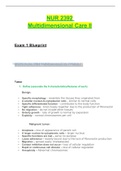
-
NUR 2392 Multidimensional Care II
- Exam (elaborations) • 16 pages • 2022
-
- $10.49
- + learn more
NUR 2392 Multidimensional Care II Exam 1 Blueprint Tumor 1. Define (associate the 9 characteristics/features of each) Benign: • Specific morphology – resemble the tissues they originated from • A smaller nuclear-to-cytoplasmic ratio – similar to normal cells • Specific differentiated function – contributes to the body function • Tight adherence - bind closely together due to the production of fibronectin • No migration – do not inv...

How much did you already spend on Stuvia? Imagine there are plenty more of you out there paying for study notes, but this time YOU are the seller. Ka-ching! Discover all about earning on Stuvia

